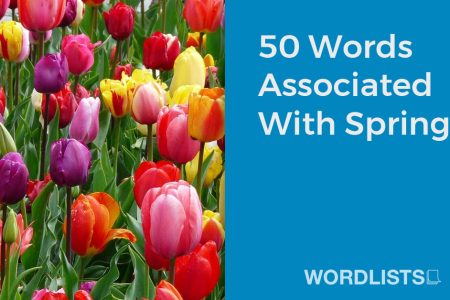Spring is a season of renewal and growth, as the world awakens from the winter and comes to life once again. From the blooming of flowers to the return of migratory birds, there are many signs of spring to enjoy. There are also many words associated with spring that help us describe and experience this season.
From terms for different types of spring weather and phenomena to words that describe the feelings and activities of spring, this list of 50 words will help you fully embrace the joys of the season.

Subscribe to our mailing list to receive FREE exclusive content and offers!
50 Words Associated With Spring Meanings
Renewal: In the context of spring, renewal refers to the process of nature renewing itself after the dormant period of winter. This can be seen in the budding of trees and the return of animals from hibernation or migration.
Rebirth: Refers to the cyclical nature of life, particularly evident in spring as plants begin to grow again and animals birth their young.
Regrowth: Describes the process of new growth after a period of dormancy or after the old has died off. In spring, this can be observed in plant life starting to grow again.
Rejuvenation: The act of making something look or feel better, younger, or more vital. Spring often brings a sense of rejuvenation to the natural world, with the return of warmer weather, longer days, and blooming plants.
Revival: This term implies a resurgence or comeback. In spring, it refers to the revival of nature after the dormant winter months.
Germination: The process by which an organism grows from a seed or a similar structure. This typically occurs in the spring when conditions are most favorable for growth.
Sprouting: The process where seeds or spores germinate and grow. It’s a common sight in spring, with new plant life sprouting up everywhere.
Blooming: When a flower opens or a plant produces flowers, which usually happens in spring due to the optimal conditions of warmth and rain.
Flowering: The period of time when a plant or tree produces flowers. This is most common in the spring when many plants come into bloom.
Petals: The brightly colored parts of a flower that attract insects for pollination. They are especially visible in spring when most flowers bloom.
Pollen: A fine powdery substance produced by flowers that fertilizes other flowers of the same species. Increased pollen production in spring can lead to seasonal allergies for some people.
Bees: Insects known for their role in pollination. Bees become more active in spring, gathering pollen from blooming flowers.
Butterflies: Insects with large, often brightly colored wings. Many species of butterflies emerge from their cocoons in spring.
Insects: A group of small animals with six legs, a body divided into three parts, and usually two pairs of wings. Many insects come out in the spring when temperatures rise and food sources become more abundant.
Birds: Warm-blooded vertebrate animals that have wings, feathers, and beaks. Many birds migrate back to their nesting grounds in the spring.
Robin: A small songbird often associated with spring. Its arrival is often considered a sign of spring in many cultures.
Bluebird: A type of songbird that is often seen as a symbol of happiness. Their mating season begins in spring, and they’re known for their bright blue color and melodious song.
Sparrow: A family of small passerine birds. They are very common and are often seen nesting and singing in spring.
Warbler: A type of songbird known for their distinctive songs. Many warbler species migrate in the spring.
Finch: Small to medium-sized songbirds, many of which are brightly colored. They’re known for their seed-eating habits and often become more visible in spring.
Hummingbird: Small birds known for their fast wing flapping rate and ability to hover in place. In spring, they can often be seen gathering nectar from flowering plants.
Thaw: The transition from winter to spring is often marked by the thawing of ice and snow, which softens the ground and allows for the growth of new plants.
Melt: Refers to the process of solid (snow or ice) turning into a liquid (water). This is common in spring when rising temperatures melt winter snow and ice.
Runoff: The draining away of water (or substances carried in it) from the surface of an area of land, a building or structure, etc. Spring often has high levels of runoff due to melting snow and spring rains.
Flooding: An overflow of water onto land that is normally dry. Flooding can be more common in spring due to snowmelt and heavy spring rains.
Streams: A small, narrow river. Streams often swell in the spring due to increased runoff from rain and snowmelt.
Rivers: A large natural stream of water flowing in a channel to the sea, a lake, or another river. Like streams, rivers can also rise in the spring due to increased water from rain and snowmelt.
Puddles: A small pool of liquid, usually water, formed on the ground. Puddles are a common sight in spring, created by rain or melting snow.
Rain: Precipitation in the form of liquid water droplets. Spring often brings rain showers which help to nourish plants and refill water bodies.
Storms: A disturbance of the atmosphere marked by wind and usually by rain, snow, hail, sleet, or thunder and lightning. Spring storms can bring much-needed water to areas and also herald the change of seasons.
Thunder: The sound caused by the rapid expansion and contraction of air surrounding a lightning bolt. Thunderstorms are more common in spring and early summer as warmer and cooler air masses interact.
Lightning: A powerful, natural electrical discharge that occurs during a storm. The frequency of lightning strikes often increases in the spring due to atmospheric instability.
Hail: Precipitation in the form of balls or irregular lumps of ice. Hailstorms are more common in the spring and summer months, often occurring during severe thunderstorms.
Snowmelt: The melting of fallen snow. This is especially common in spring when temperatures rise, and it helps to hydrate the soil and feed rivers and streams.
Green: Referring to the color most associated with plant life and spring. During spring, many plants come back to life and bring a green hue to nature.
Grass: A common type of plant with narrow leaves. After the dormancy of winter, grass begins to grow again and green up in the spring.
Leaves: The main organs of photosynthesis and transpiration in plants. In many types of trees, new leaves begin to appear in the spring after a winter of dormancy.
Trees: Perennial plants with an elongated stem, or trunk, supporting branches and leaves. Many trees start growing new leaves and flowers in the spring.
Buds: A bud is an undeveloped or embryonic shoot that occurs in the axil of a leaf or at the tip of the stem. It’s a clear sign of spring as trees and other plants begin to bud.
Saplings: A young tree. Spring is a common time for trees to start their growth, many of which begin their life as saplings.
Seeds: A flowering plant’s unit of reproduction, capable of developing into another plant. Spring is a key time for seed planting and germination, as conditions are generally favorable for growth.
Gardening: The practice of growing and cultivating plants. Spring is often seen as the start of the gardening season, with many flowers, fruits, and vegetables being planted.
Planting: The process of putting seeds or young plants into the ground to grow. This is commonly done in the spring when conditions are optimal for most plants.
Tilling: The process of preparing the earth for planting by digging, stirring, and overturning. Spring is a popular time for tilling as the ground thaws and becomes workable.
Weeding: The removal of unwanted plants that compete with desired plants for resources. With the growth of new plants in spring, weeding often becomes necessary in gardens and lawns.
Hares: A type of wild rabbit, typically associated with open fields and grasslands. Hares are often seen more frequently in the spring, particularly during their breeding season.
Orchards: A plantation of trees or shrubs maintained for food production. Many orchards bear fruit in the spring, depending on the type of tree and its location.
Fruit: The sweet or savory product of a tree or other plant that contains seed and can be eaten as food. Many fruits begin to grow in spring and are harvested later in the year.
Berries: A small, pulpy, and often edible fruit. Berries are often associated with spring and summer, and many berry plants begin producing fruit in the spring.
Grass: A common type of plant with narrow leaves. After the dormancy of winter, grass begins to grow again and green up in the spring.







